|
|
| (1) Posted by Sarah Hornecker [Wednesday, May 16, 2007 00:14] |
Some funny chess problems
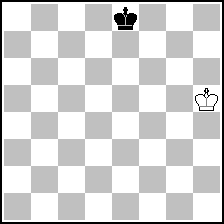 (= 1+1 ) (= 1+1 )
Retract one move (first white, then black), then h#1
J. Sunyer
Chess Amateur 1921
And if this is too easy for you:
Create a legal position with wK wQ wP wP bK where white can not win, despite having the move
John Nunn (year?)
Create a game that ends with 6. gxf8S#
Peter Rössler, 1994
And if you're still bored, here's the ultimate problem:
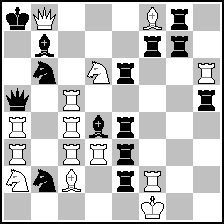 (= 14+14 ) (= 14+14 )
Position after the 58th white move. What was the 40th white move?
Pronkin and Frolkin, 1989 (original stipulation was SPG but I don't want you to have to write everything down after you solved it)
|
|
| (2) Posted by Zalmen Kornin [Thursday, May 17, 2007 01:11] |
The subject is very interesting - Leonard Barden once wrote that F. Giegold was one of the few (then, around 1970) contemporary composers with a sense of humour - Another name to be remembered is, of course, Sam Loyd (the following example is not so well known, i believe):
S. Loyd
"Chess Strategy" (?!)
around 1880 (?!)
 (= 7+3 ) (= 7+3 )
#2
The Problem has a motto, a title (also an old-fashioned costum):
"THE ARROW"
Loyd:" It is a little bagatelle I once posed in the shape of an arrow, and sent to to a friend, who, from the nature of the solution, christened it Peek-a-Bo. My friend, Capt. Mackenzie, has shown it for years as the funniest problem he ever saw. He used to bet that no one would solve it without taking back a move"
|
|
| (3) Posted by Michael McDowell [Thursday, May 17, 2007 17:52] |
Here are a couple of problems that made me smile when I first saw them.
A.Rautanen
30 Shakkiprobleemaa 1929
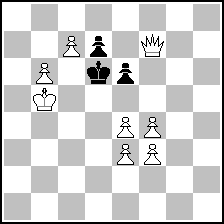 (= 8+3 ) (= 8+3 )
White mates without moving!
Solution:
1.Rotate board 90° anticlockwise (wPb3 gives check) Kd4 or Kd5
2.Rotate board 180° clockwise (wPd3 or wPd4 gives check) Kf5
3.Rotate board 90° anticlockwise (this re-establishes the initial position with Black to play) e5
4. Rotate board 90° anticlockwise – mate!
John Beasley
Chess Braintwisters 1999
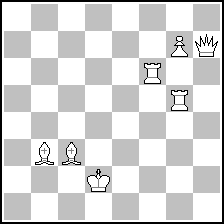 (= 7+0 ) (= 7+0 )
Kriegspiel. Black has only his king left (White knows, as 15 captures have been announced).
Black has just moved.
The curious feature of this position is that White can mate on the move if, and only if, he does not know where the black king is!
The explanation:
If the bK is somewhere in the rectangle abcde78 then White does not know precisely where it is, because it will always have had at least two alternative squares to go to, but g8Q mates in all cases. The only other possible square for the bK is a3, in which case White does know where it is, as it has just moved out of an announced check from a bishop. However, at a3 there is no mate!
|
|
| (4) Posted by Sarah Hornecker [Thursday, Aug 2, 2007 16:48]; edited by Sarah Hornecker [07-08-02] |
Ok, so you're still bored? Try this!
 (= 7+11 ) (= 7+11 )
Gerd Rinder
Die Schwalbe, June 1973, 1st prize (retro section)
White to move and draw
Oh, here the solutions to the first posting
SPOILER ALERT!
Sunyer - 1.Kg5xRh4 Rh8xQh4 (here white is written first) before 1.0-0 Qh7# (here black)
Nunn - wKg6 Qh5 Ph7 f6 bKh8
Rössler - 1.h4 d5 2.h5 Sd7 3.h6 Sdf6 4.hxg7 Kd7 5.Rh6 Se8 6.gxf8S#
Pronkin and Frolkin 1989 - 40.0-0 [1]
[1] - You can find the whole solution at http://www.janko.at/Schach/FIDE-Alben/010.b.htm
I'm sorry to Mr. Pronkin and Frolkin, my other source didn't say it won a prize in Die Schwalbe so let me add this now
|
|
| (5) Posted by Sarah Hornecker [Wednesday, Aug 22, 2007 19:02]; edited by Sarah Hornecker [07-08-22] |
I don't know if this was published before but I came up with this:
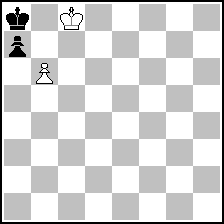 (= 2+2 ) (= 2+2 )
Set one piece to another position, then #1
(position doesn't have to be legally possible)
|
|
| (6) Posted by Sarah Hornecker [Thursday, Aug 23, 2007 22:19] |
Or what about this?
 (= 2+2 ) (= 2+2 )
Set one piece to another position, then #1
(position has to be legally possible)
Solution for the one of August 22:
Kc8->c7 and 1.b6-b7#
Solution for this:
Pb6->h2, 180° rotation and 1.a7-a8Q/B checkmate
|
|
| (7) Posted by Sarah Hornecker [Thursday, Nov 8, 2007 01:26]; edited by Sarah Hornecker [07-11-08] |
 (= 4+17 ) (= 4+17 )
White to move and draw
SH, Original
 (= 16+16 ) (= 16+16 )
Set two pieces to other fields to reach a position where white can not lose even at worst play. No white or black pieces can be taken.
SH, Original
|
|
| (8) Posted by Jacques Rotenberg [Thursday, Nov 8, 2007 04:05] |
the 2 white knights ?
|
|
| (9) Posted by Sarah Hornecker [Thursday, Nov 8, 2007 08:40]; edited by Sarah Hornecker [07-11-08] |
yes :-)
of course, "taken" means "captured"
|
|
| (10) Posted by Hauke Reddmann [Thursday, Nov 8, 2007 17:04] |
Set two pieces...to get a legal position? Or may I put
the sK into mate?
Hauke
|
|
| (11) Posted by Sarah Hornecker [Thursday, Nov 8, 2007 17:19] |
I never spoke about a legal position. Ok, you both solved it. :-)
|
|
| (12) Posted by Hauke Reddmann [Friday, Nov 9, 2007 14:21] |
That still doesn't say whether the position might be only
starting-position-illegal, but not retro-illegal.
E.g. putting the sK on the 3rd row and the wQ on the 4th
is both.
Obvious problem: How many pieces must be moved to obtain
a legal mate position? (HR, Original for MatPlusForum :-)
4 are enough, but what about 3? (Offhand I can do 3 1/2
with a bit of cheating.)
Hauke
|
|
| (13) Posted by Sarah Hornecker [Friday, Nov 9, 2007 14:40] |
oops - of course must be "two pieces except the black king" at my problem to prevent duals like Ke8->a3 Qd1->c4
|
|
| (14) Posted by Dmitri Turevski [Saturday, Nov 10, 2007 13:27] |
Hauke:
WPe2->e6
BPf7->f5
WQd1->f7
|
|
| (15) Posted by Hauke Reddmann [Sunday, Nov 11, 2007 19:58] |
Wowie!
With a bit of said cheating, you could also do
Pe2->e6, Qd1->f7 (-P). The latter is more or less
accepted as "1 change".
A SPG: 1.e4 Nh6 2.e5 Ng8 3.e6 Na6 4.Qf3 Nb8 5.Qxf7#
This should definitely go to "Best Bits".
Hauke
|
|
| (16) Posted by Dmitri Turevski [Monday, Nov 12, 2007 10:18] |
How about SPG in 4.5 with non-capturing mating move?
|
|
| (17) Posted by Vladimir Tyapkin [Monday, Nov 12, 2007 13:57] |
SPG in 3.5: 1.c3 d6 2. c4 Kd7 3.Qb3 Kc6 4.Qb5#
|
|
| (18) Posted by Dmitri Turevski [Monday, Nov 12, 2007 14:47]; edited by Dmitri Turevski [07-11-12] |
Actually, I still had that "2 1/2 changes" in mind:
1. e4 f6! 2. Qf3(Bc4) f5 3. ef Sa6 4. f6 Sb8 5. f7#
|
|
No more posts |
MatPlus.Net  Forum Forum  Promenade Promenade  Some funny chess problems Some funny chess problems |
 ISC 2024
ISC 2024 Forum
Forum  Promenade
Promenade  Some funny chess problems
Some funny chess problems 


